15 Best Hair Growth Oils for Long, Healthy Hair, Tested by Editors
Thicker hair, one drop at a time.
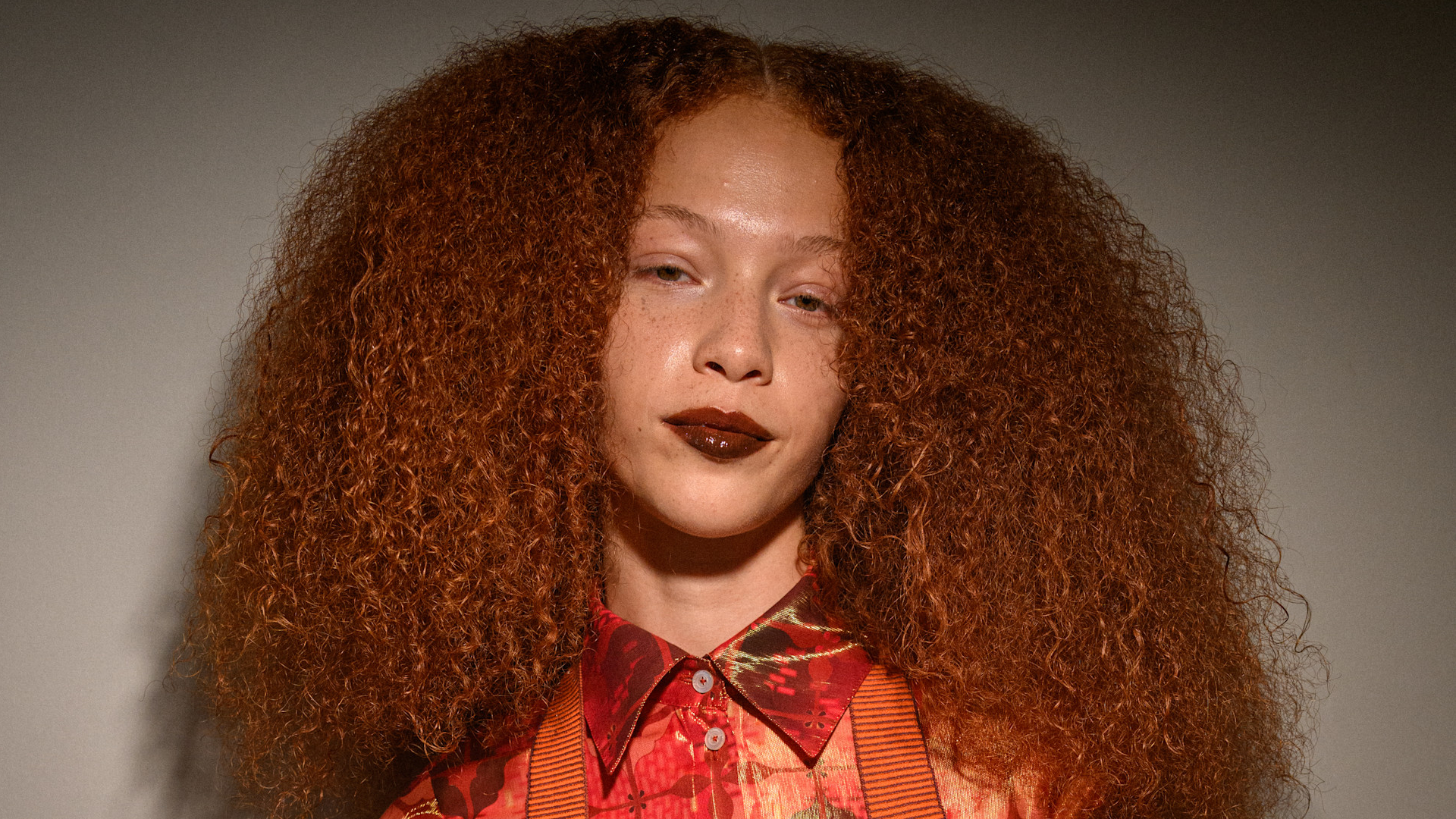
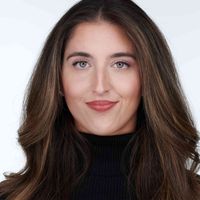
Gabrielle Ulubay
Whether you’re kickstarting your hair growth journey or looking to replace a meh product you didn't love, one of my favorite hair growth oils might be your new holy grail to boost density. Like hair growth shampoos, conditioners, and serums, hair growth oils are specially formulated with plant-based botanicals to nourish your scalp and, with very consistent use, help your hair become its healthiest, strongest, and longest.
Hair growth oils aren't a heavy-duty fix for severe hair loss. (If that’s your situation, an FDA-approved treatment like minoxidil might be a better option.) What these oils do offer is a gentle yet effective way to tackle mild thinning and promote all-around healthier hair—just be sure to check with a dermatologist if you’re unsure about the underlying cause.
Still, don’t underestimate their power. Hair growth oils have earned rave reviews and expert endorsements for good reason. "Typically made with natural oils like castor, rosemary, coconut, or argan oil, these penetrate the scalp and hair shaft, nourishing from within," explains board-certified dermatologist Kristina Collins, M.D. "Hair oils condition the scalp, improve blood circulation through massage, and strengthen hair follicles. They’re especially beneficial for those with dry, brittle hair or scalps in need of hydration." Plus, there’s no shortage of options at a variety of price points, including formulas that target not just hair growth but also issues like flakiness, oiliness, dryness—you name it.
To curate this guide, I tested and researched the most popular hair growth oils on the market and consulted with several board-certified dermatologists, brand founders, and experts—including Dr. Collins, Dara Spearman, M.D., and Mara Weinstein Velez, M.D., among others—to uncover the 15 best options out there. Together, we answered all your burning questions, like how to apply hair growth oil, how often to use it, how to pick the best formula for your unique hair goals, and more.
The Best Hair Growth Oils
- Best Hair Growth Oil Overall: Fable & Mane HoliRoots™ Pre-Wash Treatment Oil
- Best Luxury Hair Growth Oil: Augustinus Bader The Hair Oil
- Best Hair Growth Oil for Dry Hair: Virtue Healing Oil
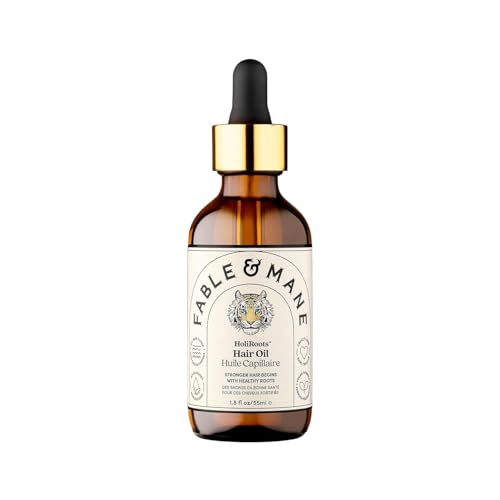
This cult-favorite pre-wash scalp and hair oil is a must-try for anyone dealing with thinning strands, dryness, or damage. It's loaded with Ayurvedic ingredients such as ashwagandha, turmeric, amla, and Bhringraj oil, which have been cherished for centuries for their growth-boosting abilities. And the product's rave reviewers agree: thousands of people swear by this treatment for hair growth. ("My hairdresser is SHOCKED," one Amazon reviewer wrote.) One of our contributing writers is still putting its hair growth claims to the test, but she's already obsessed with how easy it is to use, as well as its subtle, soothing scent of vetiver, patchouli, and coconut oil.
Size: 1 fl oz
Key Ingredients: Castor seed oil, ashwaganda, amla fruit extract (strengthening); Bhringraj oil (promotes hair growth)
What I Love: Color safe; Three sizes available (standard, value, and mini); Subtle yet sweet scent
What I Don't: Those with a scent aversion might prefer a less fragrant option
Review for MC: "I’ve always had thick hair, and while I’d call it both a blessing and a curse, I can’t help but dread the thought of dealing with hair fallout—which, as I near my due date for my first child, feels more inevitable by the day. Though I’m not experiencing it yet, I’m getting ahead of the game with this beloved formula. Once a week, I massage a few drops into my scalp before washing, and while long-term results take time, I’ve been loving the ritual of using it. The subtle (yet sweet!) scent is addictive, and it rinses out easily, leaving my scalp and hair feeling super clean and healthy and voluminous at the root." — Marisa Petrarca, Contributing Beauty Writer
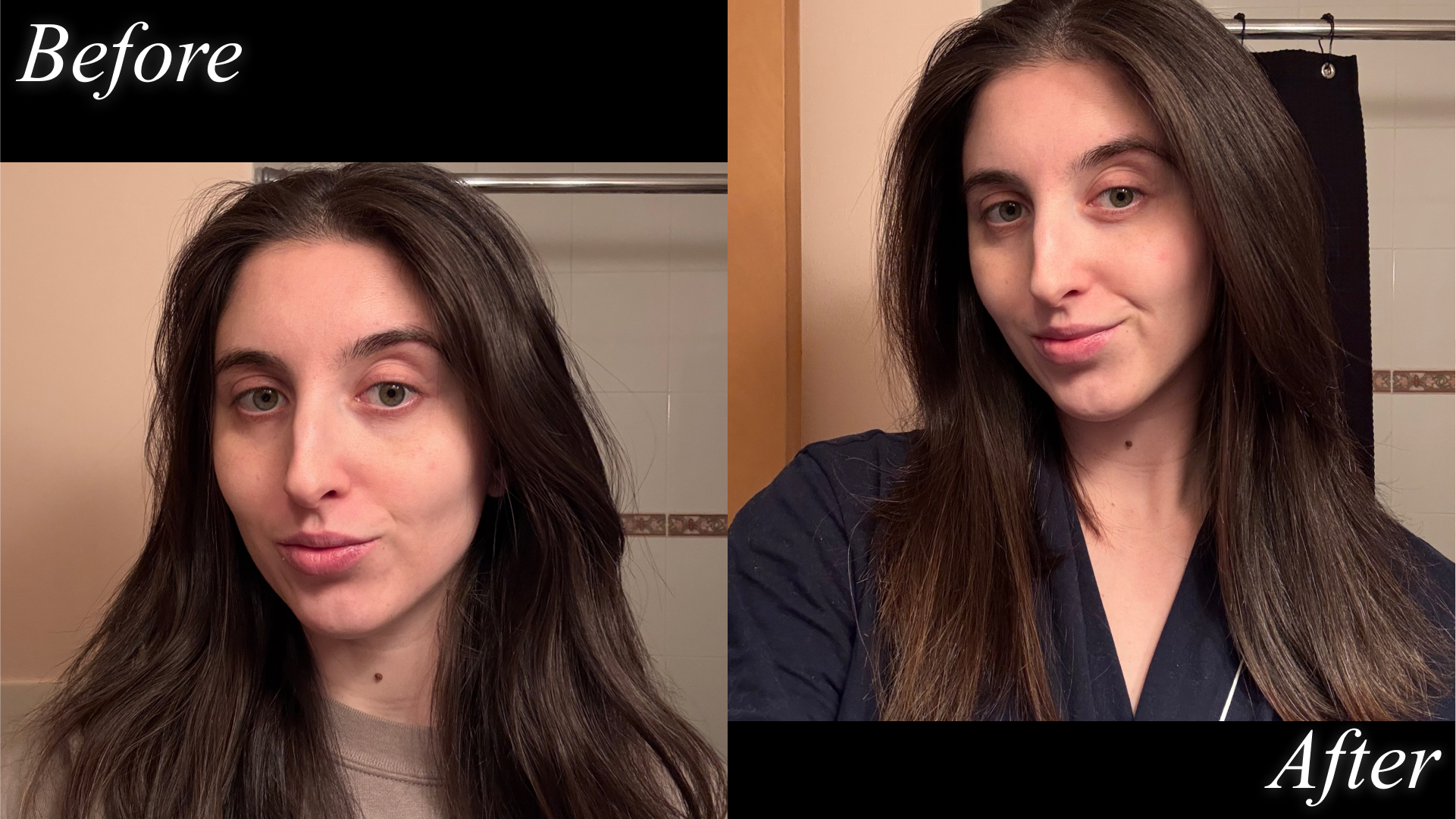
Contributing beauty writer Marisa Petrarca uses the Fable and Mane Hair Oil.
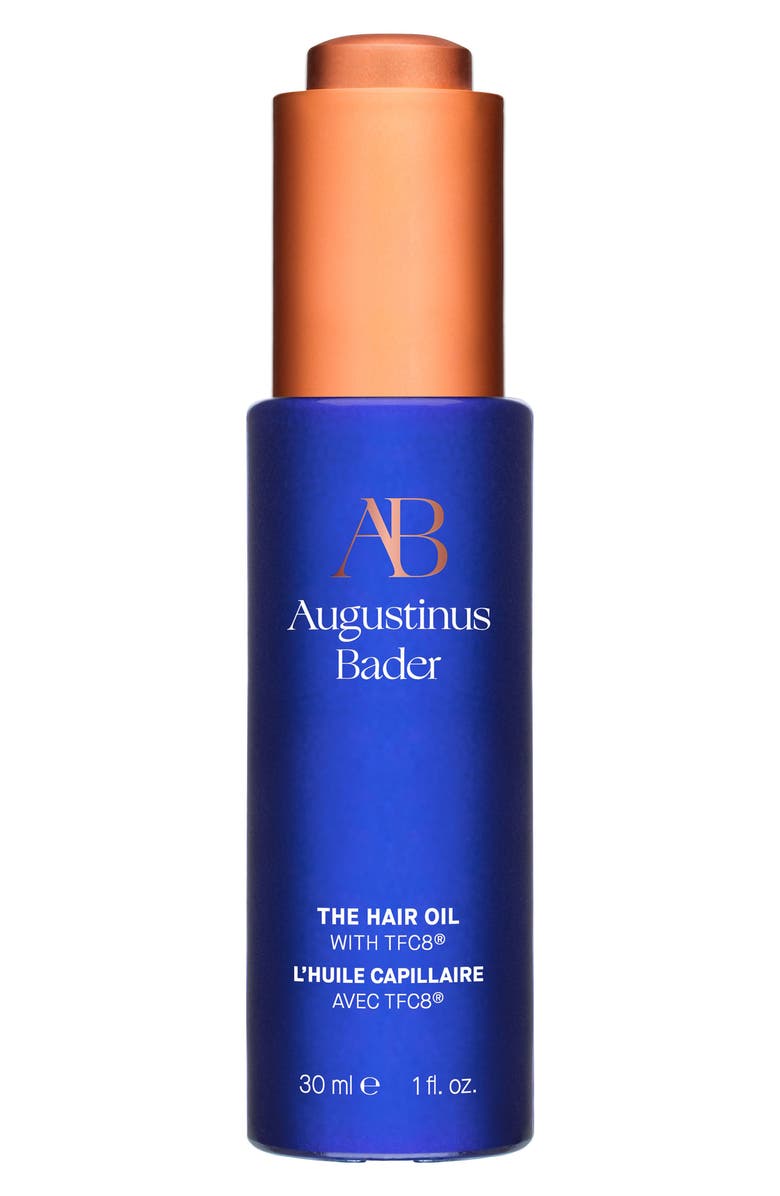
The ever-luxurious Augustinus Bader line is a go-to for celebrities, beauty editors, and anyone obsessed with high-end beauty. Its signature TFC8 complex (a proprietary blend of vitamins, lipids, and peptides) is famous for repairing and renewing skin cells. While it’s best known in the brand's skincare products, it also powers this highly coveted hair oil. Though it's not technically marketed as a hair growth oil, it works its magic by improving scalp health, strengthening strands, and reducing breakage—laying the groundwork for healthier, fuller-looking hair that can grow longer and stronger over time.
Size: 1 fl oz
Key Ingredients: TFC8 (renewing); Castor seed oil and hydrolyzed rice protein (strengthening); Argan oil (hydrating)
What I Love: Features Augustinus Bader's famed TFC8 ingredient complex; Lightweight and fast-absorbing; Adds shine
What I Don't: Most expensive option on my list
Review for MC: "This hair oil is yet another step in my getting-ahead-of-postpartum-hair-loss routine, which I apply post-shower, often after I use the aforementioned Fable & Mane product to cleanse my scalp. It's lightweight, absorbs quickly, and smells divine (equally as subtle as F&M's, yet slightly more herbal). You don't even need to apply it to your scalp—just work it through towel-dried or dry hair to add shine and help with detangling." — Marisa Petrarca, Contributing Beauty Writer
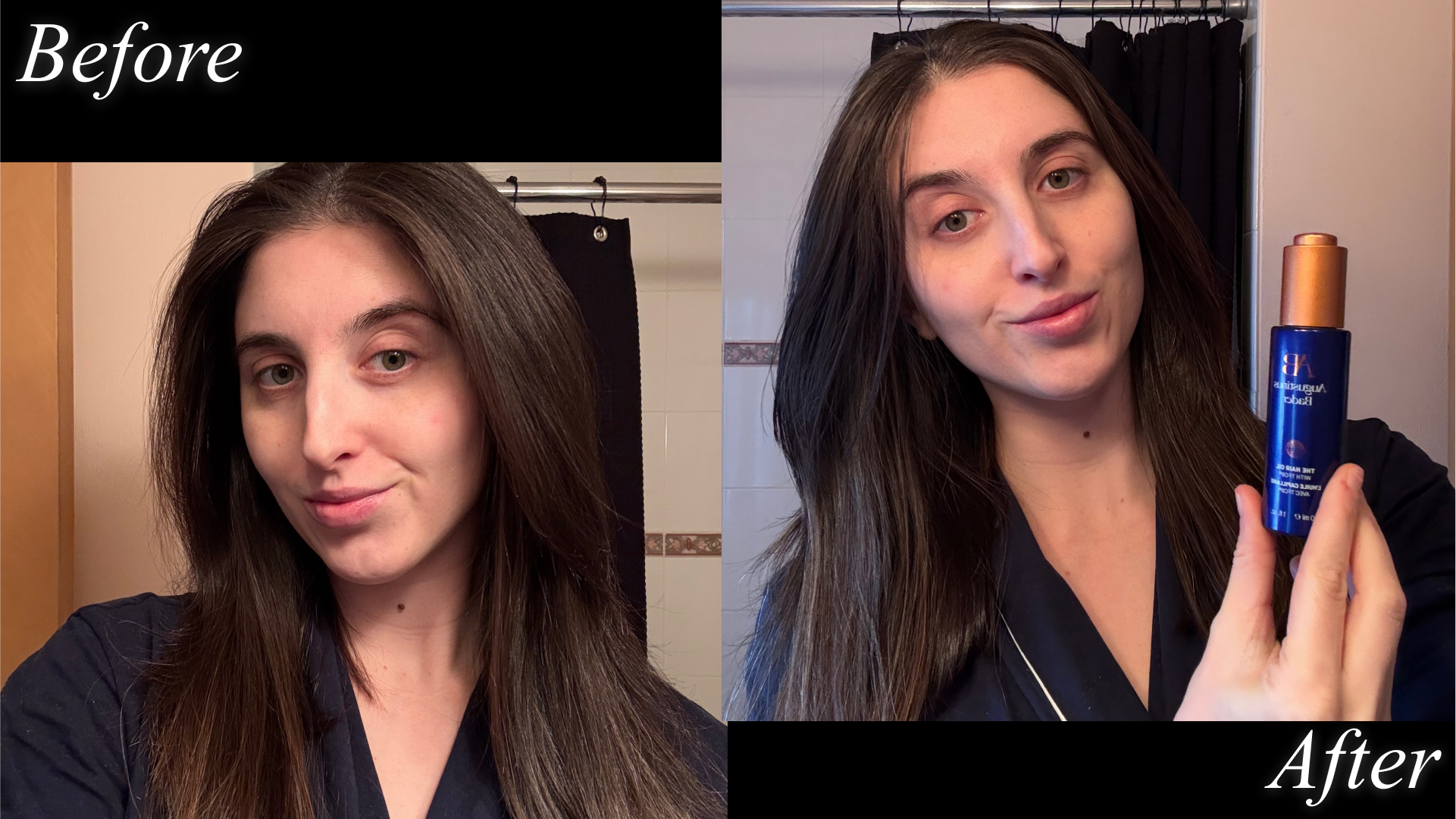
Contributing beauty writer Marisa Petrarca uses the Augustinus Bader Hair Oil.

Senior Beauty Editor Samantha Holender is obsessed with this oil because it hydrates and adds shine to her thin hair without weighing it down. (Don't worry; she'll share more in a second.) The lightweight formula is ideal for all hair types, combining coconut oil, alpha keratin, and marula seed oil to hydrate, repair, and strengthen, respectively. It also has vitamin E, which studies, like this one from 2001, show might help with hair growth.
Size: 1 fl oz
Key Ingredients: Alpha keratin (repairing and strengthening); Marula seed oil (nourishing and moisturizing); Coconut oil (hydrating); Vitamin E (protective and promotes circulation)
What I Love: Sulfate- and paraben-free; Tames frizz; Doesn't make thin hair look greasy
What I Don't: Lacks biotin, rosemary oil, or other reputed growth-boosting ingredients
Review for MC: "I have ridiculously thin hair, so applying hair oil is a risky business. I typically end up looking like a greasy mess. But this sulfate-free, paraben-free, lightweight one is the exception to the rule. It gives my hair shine (not oil), seals my split ends (there are many), and smells delicious (think: fresh meets citrus). Over the course of a few weeks, I noticed that my hair felt stronger overall—my hair looked less fried and felt stronger." — Samantha Holender, Senior Beauty Editor
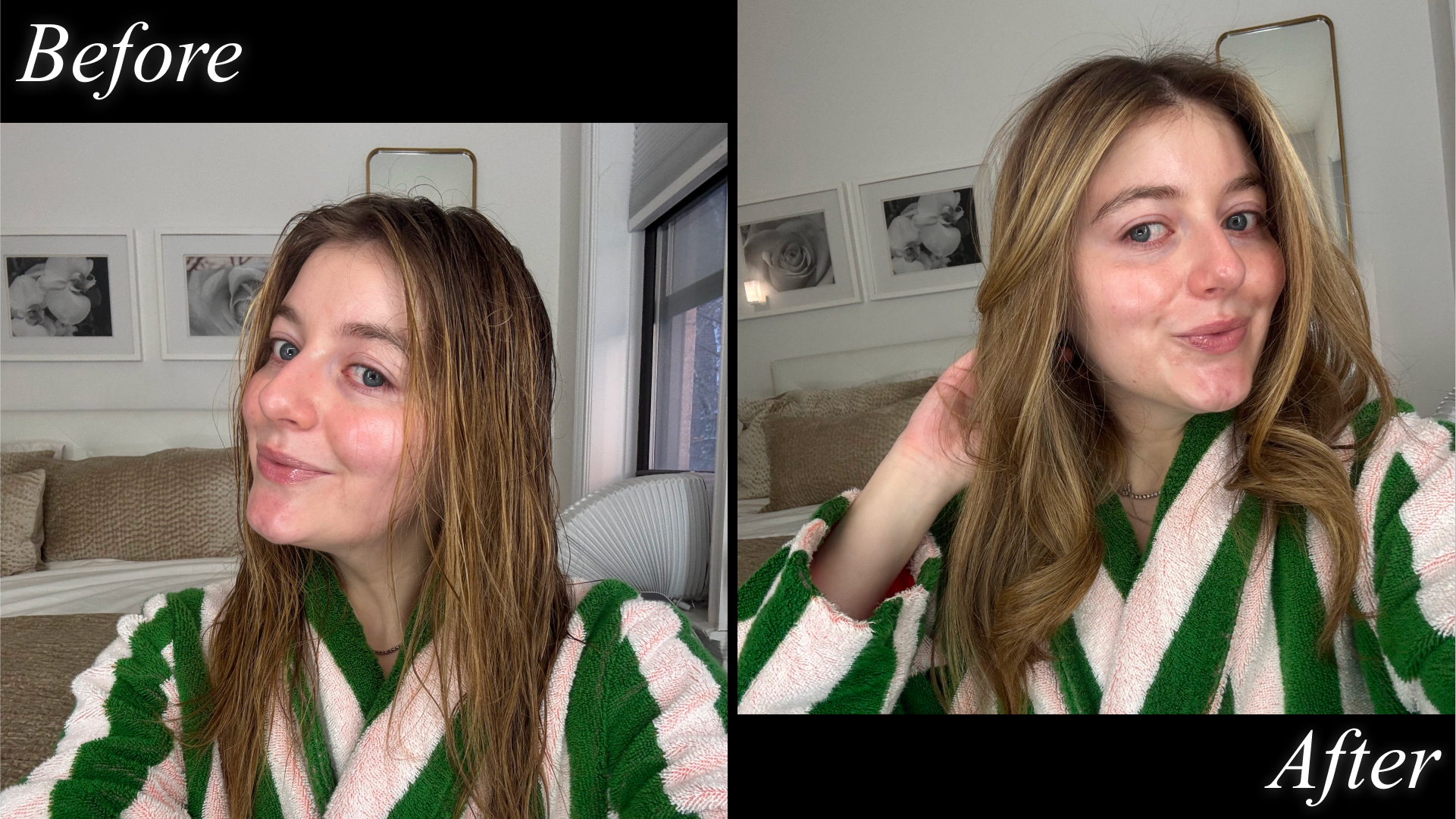
Senior Beauty Editor Samantha Holender uses Virtue's Healing Oil.
Other Hair Growth Oils I Love
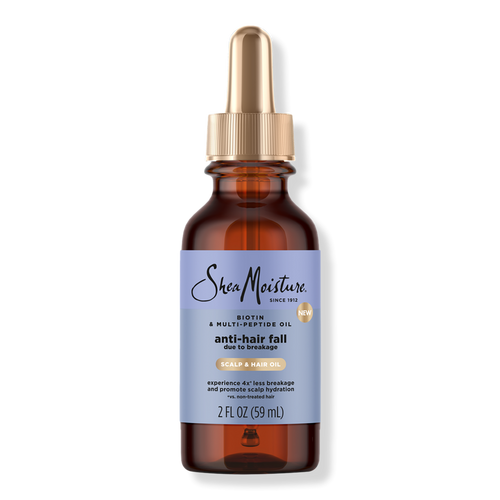
With an almost perfect five-star rating across major retailers, this budget-friendly scalp and hair oil from SheaMoisture is worth testing if you're searching for a scalp treatment to help with hair fall. The drugstore favorite nourishes the scalp while moisturizing and strengthening your strands. It's particularly effective for dry, curly, and coily hair types, thanks to intensely hydrating shea butter, which works alongside heavy-hitting hair growth ingredients such as biotin, castor seed oil, grapeseed oil, and hydrolyzed pea protein.
Size: 2 fl oz
Key Ingredients: Castor seed oil and biotin (strengthening); Grapeseed oil (supports hair growth); Hydrolyzed pea protein (repairing and strengthening)
What I Love: Contains ingredients that reduce hair fall; Widely available; Great for curly hair
What I Don't: Though those with fine-to-medium hair may find it too heavy
Customer Review: "SheaMoisture ALWAYS does wonders on my hair. This oil is amazing it truly did help protect my curls while moisturizing them. SheaMoisture doesn't play when it comes to moisturizing ur hair! 1000% recommend buying if in need of a new oil." — Ulta Beauty

For less than $10 and a lean but effective ingredient list, you’d be missing out not to give this a try if you have curly or coily hair. It’s versatile; you can massage it into your scalp, use it for hot oil treatments, or finish off your natural styles with it. However you decide to use it, it’ll deeply moisturize your dry hair and scalp and strengthen your curls. FYI: If you’re focused on overall hair health with some strengthening perks, this is the one to grab. But if thinning hair is your main concern, the aforementioned SheaMoisture option might be the better choice.
Size: 4 fl oz
Key Ingredients: Black castor oil and argan oil (strengthening); Coconut oil and grapeseed oil (promote hair growth); Olive oil (nourishes scalp and supports overall hair health)
What I Love: Under $10; Lean yet effective ingredient list; Comes in family-size and multi-packs
What I Don't: Some shoppers reported bottle leakage during delivery
Customer Review: "I have bought many times. I use it on my toddler who has type 3C. I use on her ends to seal in moisture and also on any parts her scalp is showing. Such a nice blend of oils and I think has helped in her hair growth. Try it!" — Amazon
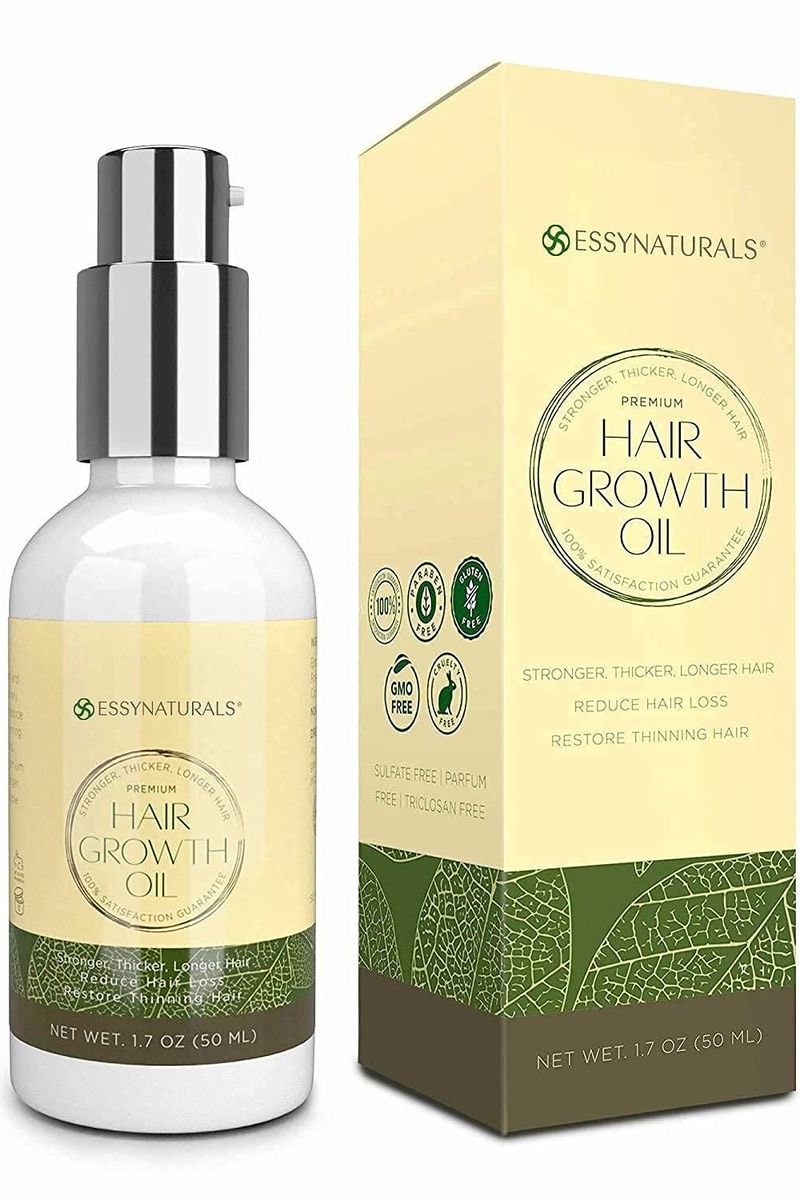
Essynaturals might not be the most well-known brand on the market, but its popular Amazon hair growth oil has a bevy of glowing reviews and experts who vouch for its ingredient lineup. Its formula uses castor oil and rosemary oil, two ingredients that board-certified dermatologist Mona Gohara, M.D., recommends for hair growth, along with caffeine, a favorite of board-certified dermatologist Jerry Shapiro, M.D. ("Caffeine reverses the effects of dihydrotestosterone [DHT], the main hormone involved in hair loss," he explains.)
Size: 2 fl oz
Key Ingredients: Castor seed oil and biotin (strengthening); Rosemary oil and caffeine (promote hair growth)
What I Love: Uses expert-loved hair growth ingredients; Glowing reviews; Affordable
What I Don't: Not widely available
Customer Review: "When I ordered this, I wasn't really confident it would do anything, but almost immediately (after a week or so), I noticed a HUGE difference in the amount of hair I was losing, as in I wasn't losing it in clumps anymore! Now I am a month into using this product regularly and my hair actually feels thicker and I'm definitely losing significantly less hair! I usually put it in the night before I want to wash it and leave it in overnight." — Amazon
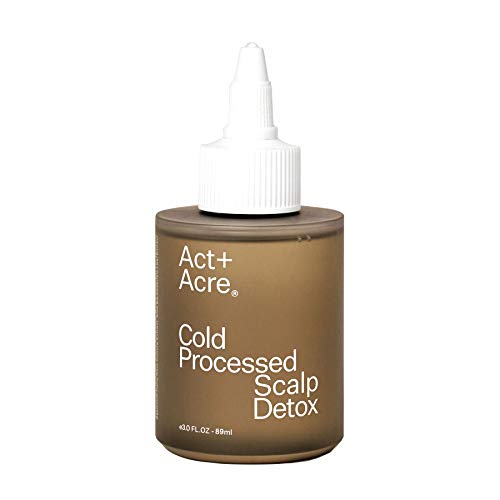
If you’re new to Art + Acre, it’s the world’s first cold-processed hair wellness brand. Translation: The ingredients skip high heat during production to preserve the potency of its plant-based formulas. One of the brand’s standout products, the Scalp Detox Oil, seen here, is a bestseller for hair thinning. It uses ingredients that tackle scalp dryness, buildup, and thinning to help create the perfect foundation for healthier, stronger hair.
Size: 3 fl oz
Key Ingredients: Moringa seed oil and baobab oil (strengthening); Basil extract and aloe vera (promote hair growth)
What I Love: Recognized by the National Psoriasis Foundation; Subscription offered on the brand's website; Only needs to be used once weekly to see results
What I Don't: Not for oily hair types
Customer Review: "Absolutely amazed by the results of this product! After just a few uses, my scalp feels revitalized and rejuvenated. The formula is gentle yet effective, leaving my hair feeling clean, nourished, and incredibly soft. I've struggled with dry scalp issues for years, but this product has truly been a game-changer for me. Plus, the natural ingredients are a huge bonus. Highly recommend to anyone looking to improve the health and appearance of their hair and scalp!" — Amazon
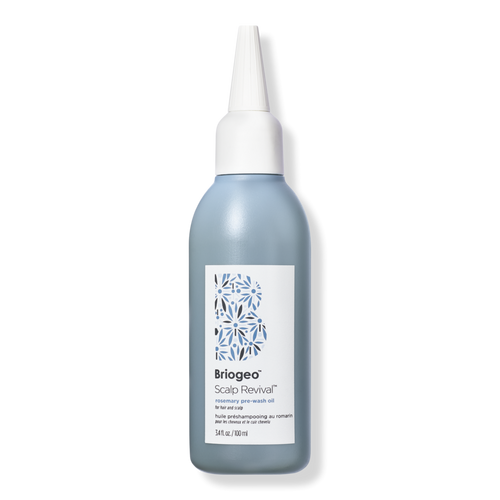
This isn’t the only pre-wash hair growth oil treatment we’re loving right now (Fable & Mane snagged the title of best overall), but this one deserves a special shoutout for its precision applicator, effectiveness on all hair types, and lineup of science-backed hair growth ingredients. Beyond its growth-boosting benefits, it’s also a savior for dry, itchy, and flaky scalps, thanks to the soothing trifecta of tea tree oil, calming bisabolol, and ultra-hydrating glycerin.
Size: 3.4 fl oz
Key Ingredients: Castor seed oil and biotin (strengthening); Rosemary seed oil (promotes hair growth); Coconut oil (hydrating)
What I Love: Works on fine and straight to thick and coily hair types; Bottle and cap are fully recyclable; Soothes dry, itchy scalps
What I Don't: Some reviewers found that it left their hair greasy
Customer Review: "I’ve been looking for a simple scalp oil with rosemary, and this is my favourite so far! I struggle with alopecia areata and incorporating this into my weekly routine has definitely made a difference in new growth." — Sephora
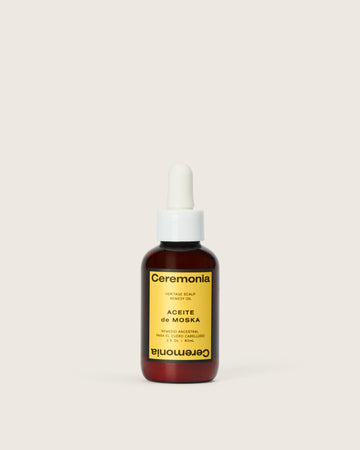
We get it—using a hair oil to treat an oily scalp might sound counterintuitive, but trust us, this one won’t add to the greasiness. One of its main ingredients is clarifying rosemary leaf extract, which targets excess sebum and product buildup, thus creating the ideal foundation for healthy hair growth. Pair that with castor oil, and you’ve got a formula that helps promote flake-free scalps and thicker, healthier strands (with consistent use, of course).
Size: 2 fl oz
Key Ingredients: Castor and chia seed oil (strengthening); Rosemary extract (antioxidant and soothing); Aloe vera (soothing); Passion fruit oil (protective)
What I Love: Prioritizes scalp health; Helps with dryness and flakiness; Can be used on the scalp for 10-15 minutes or overnight
What I Don't: Thick texture might be too heavy for thin hair
Customer Review: "I use this on hair-wash days to help balance my scalp and I love it. I use it in conjunction with the papaya scalp scrub and the scalp massager to really spread the product around my scalp, and then wash it out. I have issues with a dry/flaky and oily scalp, and using this in my routine always leaves my scalp feeling fresh and clean!" — Sephora

This best-selling hair growth oil uses fermentation to boost the strengthening benefits of one of its star ingredients, green tea. "Fermentation breaks down natural molecules and makes them smaller, so it’s easier for them to absorb deeper into your skin’s surface," says Dr. Zubritsky. True to Olaplex’s signature formula, it also features Bis-Aminopropyl Diglycol Dimaleate to repair broken disulfide bonds, the culprits behind brittle, breakage-prone hair. Bonus: It adds shine, tames flyaways, and offers heat protection up to 450°F.
Size: 1 fl oz
Key Ingredients: Fermented green tea oil and Bis-aminopropyl diglycol dimaleate (strengthening); Grapeseed oil (moisturizing and protective)
What I Love: Repairs damage; Offers heat protectant; Adds shine
What I Don't: Contains fragrance, which may not be ideal for those with sensitive scalps
Customer Review: "My holy grail hair oil!! I usually wear my hair curly, so you would never realize how dry my ends were. I started wearing my hair straight, and MY GOD. I’ve been using this, and my hair is literally so moisturized." — Sephora
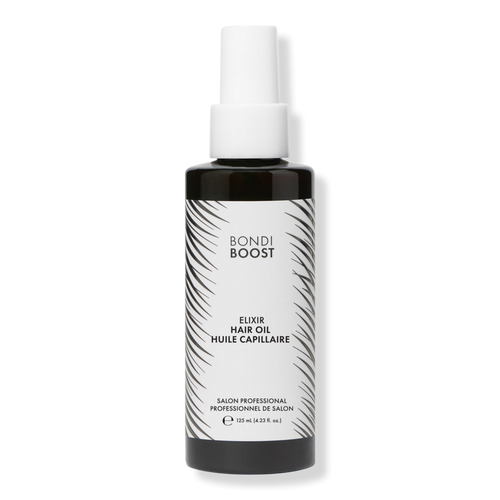
If you’re looking for a multi-tasking hair growth oil that leaves your scalp clean, hydrated, and flake-free, your strands noticeably stronger and potentially thicker with consistent use, and so soft your friends and family can’t stop commenting on it, this Aussie-born BondiBoost option is one to try. It uses sweet almond oil, argan oil, and coconut oil, which work together to deeply moisturize, condition, and smooth your hair for results that feel as luxurious as a deeply hydrating hair mask.
Size: 4.23 fl oz
Key Ingredients: Castor seed oil (strengthening); Saw palmetto and peppermint oil (promote hair growth)
What I Love: Leaves hair feeling super soft; Subscribe and save option on the brand's website; Safe for chemical-treated hair
What I Don't: Not TSA carry-on friendly
Customer Review: "I'm officially obsessed! I used this on one of my "oily hair days" about an hour before I was planning on getting into the shower. Honestly, a little bit of product goes a long way. Two pumps later my hair looked like a giant grease ball (in the best way possible). I was surprised by how clean smelling the scent is. I massaged the product in and let it sit for about an hour then jumped into the shower. I made sure to wash my hair twice just in case. After I blow dried my hair--I was shocked. Literally shook to the core with how soft my hair was. I went to everyone in my house and told them to touch my hair, that's how soft it was. I'm planning on using it 1x/week but so far 10/10 recommend!" — Amazon

This blue-bottled formula is formulated to help with hair growth wherever it’s applied, but it’s earned a ton of praise for helping people restore fullness at their hairline. The brand recommends using just a few drops on your hairline, part, or any area where you’d like to see growth, then massaging it in—no rinsing required!
Size: 2 fl oz
Key Ingredients: Biotin and ashwagandha root extract (strengthening); Turmeric root extract and ginger root extract (promote hair growth)
What I Love: The brand promises results in eight weeks; Lightweight gel-serum texture; Safe for use while pregnant or nursing
What I Don't: Some people aren’t fans of the orange tint (though it’s a helpful reminder to ensure it’s fully massaged in)
Customer Review: "I’ve been trying this hair density boosting treatment and it has worked miracles on my hair! I’m so happy that I was able to try this product. I have been struggling with hair loss for quite a while now. After using this product faithfully, I have seen a lot of new hair growth, especially right at my hairline. This product didn’t make my hair look too greasy, but I tried to only use this close to my hair wash days and I’m really happy with it." — Sephora
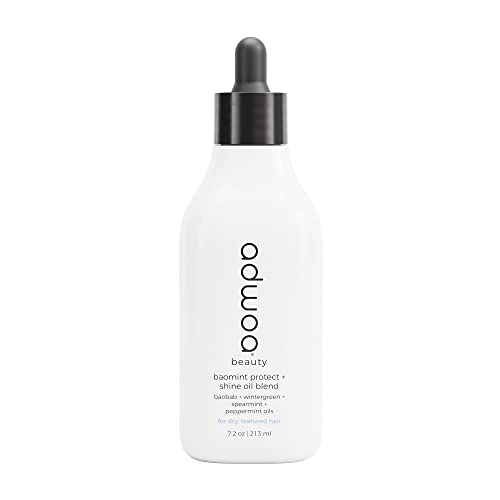
This minty, Clean at Sephora-approved hair growth oil delivers major moisture, which is why it’s so coveted for thick and curly hair types. It not only hydrates dry scalps and helps with dandruff, but it also nourishes the hair shaft, boosting softness and shine. Thanks to its high vitamin E and antioxidant content, it also protects against UV damage that can lead to dryness, color fading, and brittleness. Grapeseed oil is also part of the mix, and some studies show promise for it helping with hair growth.
Size: 7.2 fl oz
Key Ingredients: Baoab oil (strengthening and hyddrating); Pomegranate seed oil (protective); Coconut oil (hydrating); Rosemary oil (promotes hair growth)
What I Love: Deeply hydrating, making it perfect for thick and curly hair types; Protects against UV damage; Comes in a mini size ideal for travel
What I Don't: May be overly hydrating for fine or thin hair
Customer Review: "I use this as an oil treatment for my scalp before showering. I apply it and use a scalp massager for about 5-10 minutes. Have seen improvement in flaky scalp dryness, more hair growth, and overall improved hair health." — Sephora
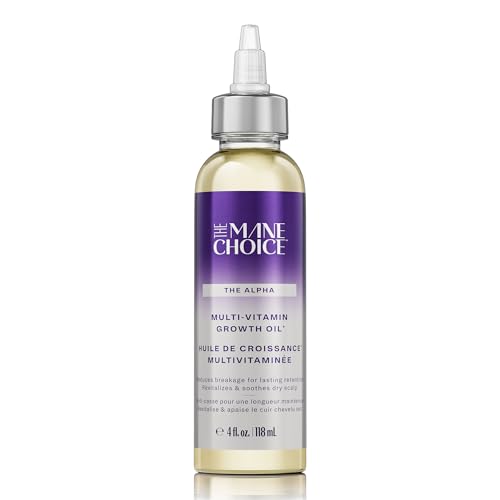
This hair growth oil is packed with multiple science-backed ingredients that Dr. Collins recommends looking for in an effective hair growth oil, including castor seed oil, which she says "supports hair follicle health and improves scalp circulation," rosemary oil, which has been "clinically shown to be as effective as minoxidil in stimulating hair growth," and biotin, which "strengthens the hair shaft and reduces shedding," among others. According to the brand, it’s gentle enough for daily use, and it's earned thousands of five-star ratings across the board.
Size: 4 fl oz
Key Ingredients: Castor seed oil and biotin (strengthening); Rosemary extract (promotes hair growth); Tea tree oil (antimicrobial)
What I Love: Largest and one of the most affordable options on my list; Contains multiple dermatologist-recommended ingredients for hair growth and strengthening; Gentle enough for daily use
What I Don't: Some shoppers reported issues with the bottle leaking
Customer Review: "My sister recommended this product for reinvigorating hair growth in my temples and top of head where my hair had been thinning. She has been using it and raved about how it has helped her hair. All her thinned spots have grown back in again. I was skeptical because of how long I have had this problem (long time use of chemicals and weaves) but thought I would give it a try. I have used it each evening for a few weeks now along with a vibrating scalp massager product she recommended from Vanity Planet made by Vitagoods. Well...my hair is growing back. I am truly amazed!" — Amazon
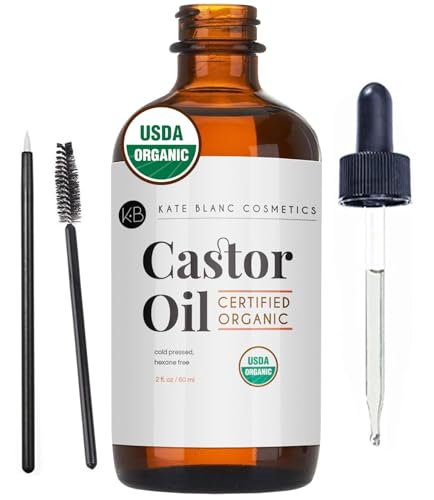
All of the board-certified dermatologists that I consulted for this piece recommended castor oil, because, per Dr. Collins, "it supports hair follicle health and improves scalp circulation." With over 80,000 five-star reviews, this pure, cold-pressed formula clearly delivers results. And it’s not just for your scalp; this bottle even comes with a spoolie for easy application to your lashes and brows.
Size: 2 fl oz
Key Ingredients: 100 percent castor oil (strengthening)
What I Love: USDA-organic; No added chemicals or synthetic ingredients; Can also be used on brows and lashes
What I Don't: Its high potency may cause irritation or require dilution with a carrier oil
Customer Review: "I wish someone told me about this 20 years ago! I've been using this oil for year and a half now and I can tell that it works for sure. I always wanted a long hair but my hair was very thin and every time I tried to grow it I would get to the point when I could gather it in my fist, feel somewhat of a rats tail, get frustrated and cut it off. Now my hair is below my shoulder blades and I can feel something substantial when I gather it in my fist and it's so soft and silky." — Amazon
What to Look for in a Hair Growth Oil
Different hair growth oils are best for different hair types and needs. Board-certified dermatologist and medical director for Keeps Peter Young, M.D., reiterates that ingredients in each oil support healthy hair growth, giving the appearance of thicker hair, rather than growing net-new hair from nowhere. However, hair growth oils can still go a long way.
"Your hair has fat in it, and oils are pretty much pure fat, so putting them on your hair can help restore those naturally-occurring fats," Dr. Young explains. "Oils high in saturated and monounsaturated fats are good because these types of fatty acids penetrate the hair strand more easily. Oils with polyunsaturated fats, on the other hand, don’t have the same effect."
Which so-called optimal fats should you look out for? "One option is coconut oil," he says. "In fact, one study showed that coconut oil assisted with decreasing how much protein the hair lost, which basically means it prevented the hair from getting weaker. Another oil that’s high in saturated fat is palm oil (such as saw palmetto oil), and some options high in monounsaturated fats are almond oil, olive oil, and argan oil."
When shopping for hair growth products of all types, Dr. Young also recommends "plant-based, organic, and raw" ingredients such as biotin, caffeine, and green tea. These are "science-backed ingredients designed to support hair growth and give the appearance of thicker, healthier-looking hair," he says.
How to Use a Hair Growth Oil
It bears repeating: hair growth begins with a healthy scalp. For that reason, Dr. Gohara instructs to massage hair growth oils directly into the scalp to stimulate hair at the root. "Once you’ve shown your scalp lots of love," she says, "you can carry the product through to the ends."
Personally, I use a hair growth oil every time I wash my hair. Anabel Kingsley, master trichologist and president of Philip Kingsley, taught me how to apply oil: After I've detangled my hair and applied my favorite leave-in conditioner, I apply my hair growth oil along my part line. Then, I make other part lines across my head, ear to ear, about an inch apart. Along each part line, I drop thin layer after thin layer of oil, rubbing it into my scalp with my finger every time. Once I'm done, I massage my scalp with my fingers or with a scalp massager so that the oil distributes evenly and absorbs more easily.
How Often to Use Hair Growth Oil
Read the instructions on the back of your hair growth oil very carefully before committing to an application routine. "Some oils have you apply once a day while others are more frequent," Dr. Gohara points out. She adds that it's perfectly all right to use multiple hair products at once, so long as you "couple your hair growth oils with a shampoo and conditioner routine to make sure your hair is getting as clean and nourished as possible." Clarifying shampoos are a perfect companion for hair growth oils, she notes.
Still worried that adding an oil to your regimen will make your hair look greasy? Dr. Gohara points out that many hair growth oils are applied before showering. But if the oil needs to be applied in the morning, you can always wear a sleek bun or ponytail. Indeed, there are countless elaborate updos or quick, easy updos for a day of hair oiling.
Why Trust Marie Claire
Marie Claire is an expert in skin care and hair growth, covering everything from the causes of thinning, aging hair to firsthand experiences with treatments such as Alma TED.
Beauty Writer Marisa Petrarca brings nearly a decade of expertise to this story and has tested numerous hair growth oil treatments. For this story, she consulted several board-certified dermatologists for their insight into what to look for in a hair growth oil, how to use it for best results, and more.
How We Tested
For this story, we sourced editor favorites and tested over 20 hair growth oils. We scoured the Internet for customer reviews to ensure each was rated highly, and consulted with board-certified dermatologists. We evaluated each option based on ingredients, size, texture, overall performance, and more.
Meet the Experts

Kristina Collins, MD, is a double-board-certified dermatologist in Austin, Texas, specializing in Mohs micrographic surgery, as well as surgical and cosmetic dermatology. She is also the co-founder of Austin Skin Physicians and founder of Foy by Dr. Kristina Collins MD.
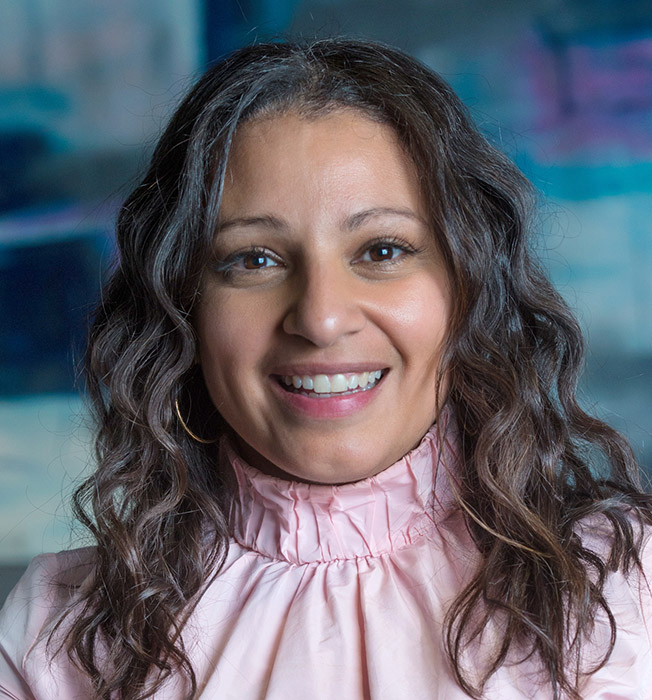
Dr. Mona Gohara is a board-certified dermatologist who graduate medical school with AOA Honors before training as a dermatologist at Yale. Currently, she is the vice president of the Women’s Dermatologic Society as well as a member of The American Academy of Dermatology and The American Society For Dermatologic Surgery.
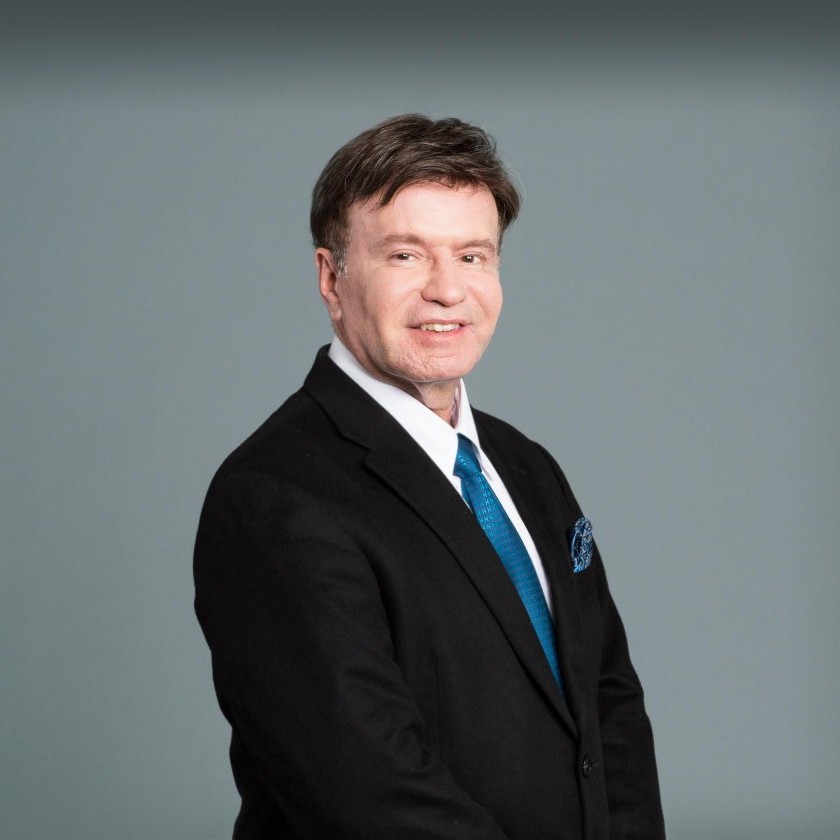
Dr. Shapiro is a dermatologist at the New York University School of Medicine who specializes in hair loss and combatting both and female- and male-pattern hair loss. He is particularly committed to finding healthy, nonsurgical methods of fighting hair loss and thinning.

Dr. Lindsey Zubritsky is a board-certified dermatologist who specializes in general medical dermatology, surgical dermatology, cosmetics, and pediatric dermatology. She is active on social media and passionate about demystifying skincare and debunking dermatological misconceptions. She is also a social media ambassador for and Fellow of the American Academy of Dermatology, an editor for the Journal of the American Academy of Dermatology (JAAD), and has contributed to a number of magazines.
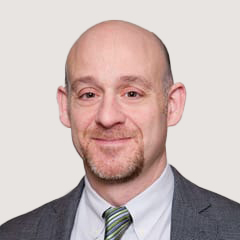
Peter C. Young, MD is the Keeps Medical Director and a board-certified dermatologist. Dr. Young had a distinguished career serving as a physician in the U.S. Army for nine years before going on to practice dermatology in Massachusetts for 22 years. In addition to his published medical articles, Dr. Young has also been a speaker at national medical meetings on teledermatology and is a fellow of the American Academy of Dermatology. Dr. Young is currently located in Estero, FL.
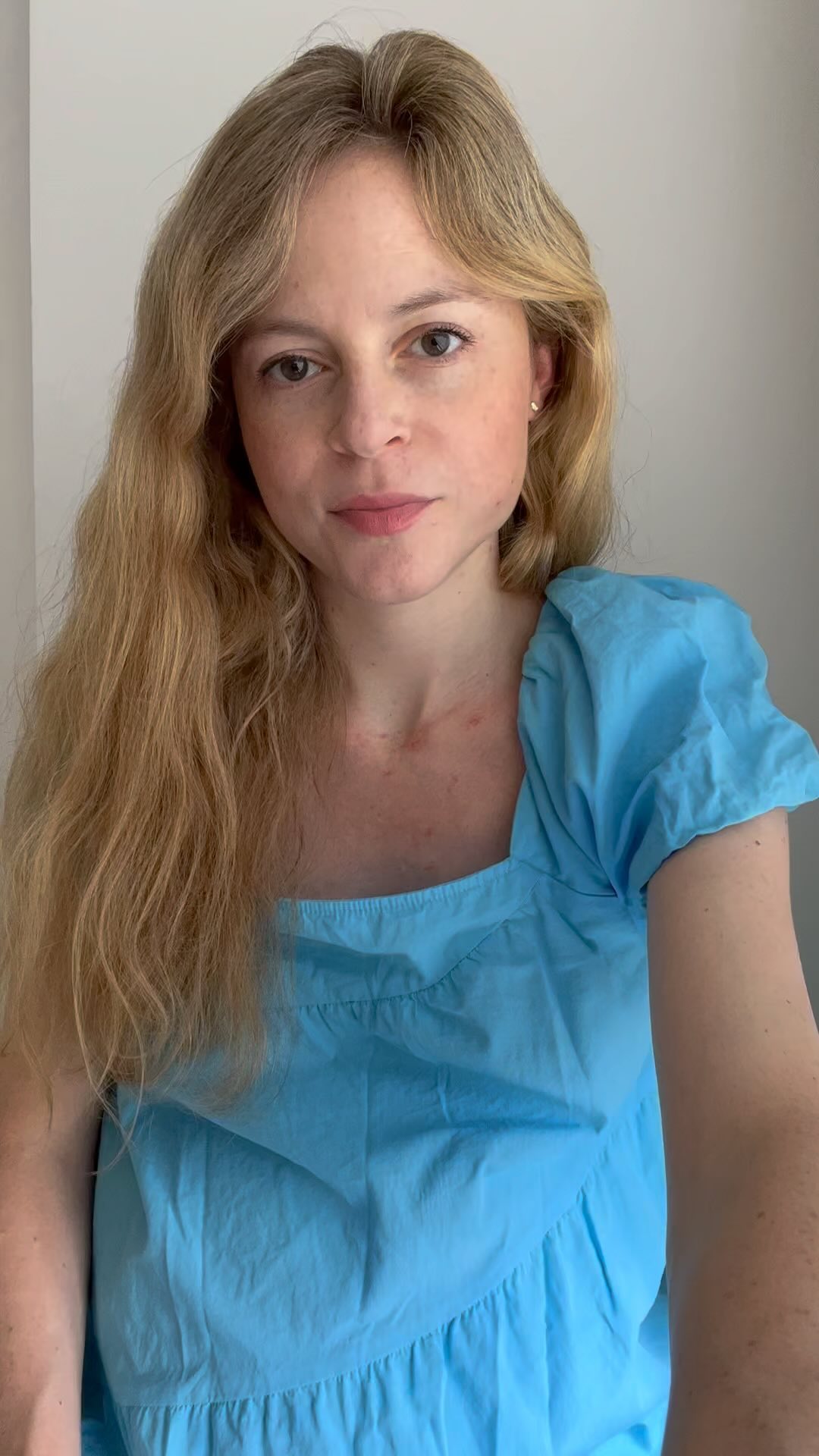
Anabel Kingsley is a trichologist and president of Philip Kingsley, a haircare brand devoted to improving hair and scalp health from the inside out.
Get exclusive access to fashion and beauty trends, hot-off-the-press celebrity news, and more.

Marisa Petrarca is a writer and editor based in Saint Paul, Minnesota, specializing in beauty, wellness, fashion, and lifestyle. She previously served as the Senior Beauty and Fashion Editor at Grazia USA and Beauty and Style Editor at Us Weekly. Her expertise spans breaking beauty news, shopping roundups, product reviews, and explainer articles on popular topics in skin, makeup, and aesthetics. Her work has been featured in PS, Cosmopolitan, Allure, NewBeauty, InStyle, and The Zoe Report, among others. Marisa holds a bachelor's degree in English literature from Wagner College. Follow her on Instagram @Marisa Petrarca.
- Gabrielle UlubayBeauty Writer